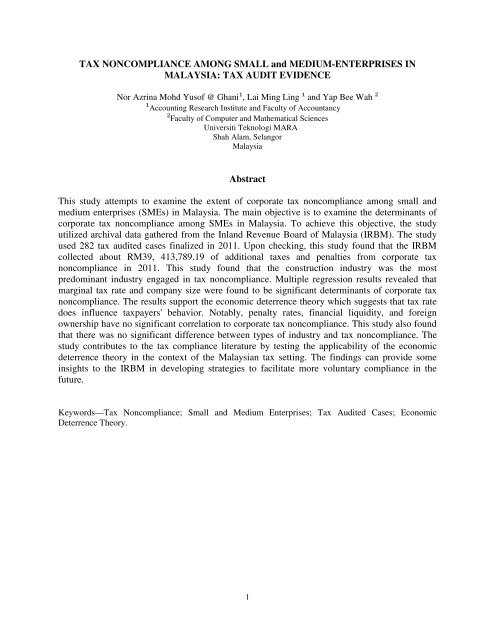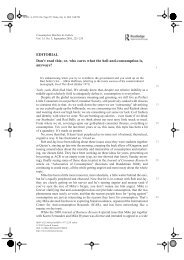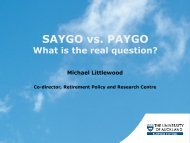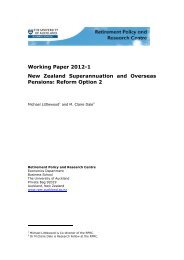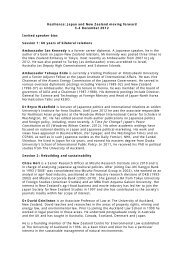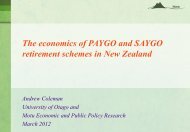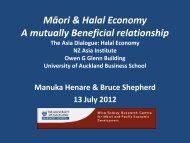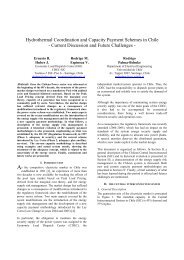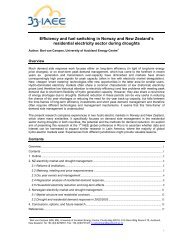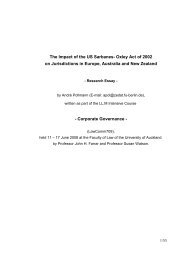TAX NONCOMPLIANCE AMONG SMALL and MEDIUM ...
TAX NONCOMPLIANCE AMONG SMALL and MEDIUM ...
TAX NONCOMPLIANCE AMONG SMALL and MEDIUM ...
Create successful ePaper yourself
Turn your PDF publications into a flip-book with our unique Google optimized e-Paper software.
<strong>TAX</strong> <strong>NONCOMPLIANCE</strong> <strong>AMONG</strong> <strong>SMALL</strong> <strong>and</strong> <strong>MEDIUM</strong>-ENTERPRISES IN<br />
MALAYSIA: <strong>TAX</strong> AUDIT EVIDENCE<br />
Nor Azrina Mohd Yusof @ Ghani¹, Lai Ming Ling ¹ <strong>and</strong> Yap Bee Wah ²<br />
¹Accounting Research Institute <strong>and</strong> Faculty of Accountancy<br />
²Faculty of Computer <strong>and</strong> Mathematical Sciences<br />
Universiti Teknologi MARA<br />
Shah Alam, Selangor<br />
Malaysia<br />
Abstract<br />
This study attempts to examine the extent of corporate tax noncompliance among small <strong>and</strong><br />
medium enterprises (SMEs) in Malaysia. The main objective is to examine the determinants of<br />
corporate tax noncompliance among SMEs in Malaysia. To achieve this objective, the study<br />
utilized archival data gathered from the Inl<strong>and</strong> Revenue Board of Malaysia (IRBM). The study<br />
used 282 tax audited cases finalized in 2011. Upon checking, this study found that the IRBM<br />
collected about RM39, 413,789.19 of additional taxes <strong>and</strong> penalties from corporate tax<br />
noncompliance in 2011. This study found that the construction industry was the most<br />
predominant industry engaged in tax noncompliance. Multiple regression results revealed that<br />
marginal tax rate <strong>and</strong> company size were found to be significant determinants of corporate tax<br />
noncompliance. The results support the economic deterrence theory which suggests that tax rate<br />
does influence taxpayers' behavior. Notably, penalty rates, financial liquidity, <strong>and</strong> foreign<br />
ownership have no significant correlation to corporate tax noncompliance. This study also found<br />
that there was no significant difference between types of industry <strong>and</strong> tax noncompliance. The<br />
study contributes to the tax compliance literature by testing the applicability of the economic<br />
deterrence theory in the context of the Malaysian tax setting. The findings can provide some<br />
insights to the IRBM in developing strategies to facilitate more voluntary compliance in the<br />
future.<br />
Keywords—Tax Noncompliance; Small <strong>and</strong> Medium Enterprises; Tax Audited Cases; Economic<br />
Deterrence Theory.<br />
1
1. INTRODUCTION<br />
To date, the pervasiveness of tax noncompliance remains of serious concern to the majority of<br />
tax administrators around the world. Tax noncompliance not only poses a serious threat to<br />
effective tax <strong>and</strong> voluntary compliance; it also has a negative impact on the economy. In 2008-<br />
2009, Her Majesty’s Revenue <strong>and</strong> Customs (HMRC) estimated the United Kingdom tax gap to<br />
be around £42 billion, <strong>and</strong> of this, £15 billion was due to tax fraud, evasion <strong>and</strong> some criminal<br />
activities (HMRC, 2010). Whilst the Inl<strong>and</strong> Revenue Board of Malaysia (IRBM) reported that<br />
the additional taxes <strong>and</strong> penalties of 2010 amounted to about RM1,013.63 million of the<br />
finalized audited corporate tax cases (IRBM, 2010). The rising tax noncompliance has urged the<br />
government <strong>and</strong> tax administrators to examine the factors that cause tax noncompliance.<br />
Over the years, there has been a plethora of studies to examine tax compliance behavior.<br />
However, a majority of these studies focused on compliance behavior of individuals; very few<br />
studies focused on corporate taxpayers. This is surprising because in most developed <strong>and</strong><br />
developing countries, corporate income tax contributes a substantial portion of the federal<br />
revenue collections. In Malaysia, approximately 50 per cent of total revenue collected is derived<br />
from corporate income tax. Notably, the Ministry of Finance reported that the corporate sector<br />
contributed about RM44 billion to the federal government in 2011 (Ministry of Finance, 2011).<br />
This amount has increased by 21.2% from the revenue contributed by the corporate sector<br />
forecasted in 2010 (Ministry of Finance, 2010). The fact demonstrates the importance of the<br />
corporate income tax to the federal government <strong>and</strong> given its importance, it is imperative for the<br />
IRBM to enhance their enforcement activities to deter corporate tax noncompliance each year.<br />
Allingham <strong>and</strong> S<strong>and</strong>mo (1972) argued that there are two effective ways to deter noncompliance;<br />
first, to increase the penalty for tax noncompliance <strong>and</strong> second, to increase tax audit. In Malaysia,<br />
with effect from the year of assessment (YA) 2008, under Section 113 (2) of the Income Tax<br />
Act (1967), the penalty rate for incorrect return found in tax audit can be equal to the amount of<br />
tax undercharged (100%) (IRBM, 2009). Arguably, this penalty rate is rather high. With regard<br />
to tax audits, in Malaysia, tax audits became a core activity after the self-assessment system<br />
(SAS) replaced the official assessment system in 2001. For instance, in 2010, the IRBM (2010)<br />
reported that there were 1,732,258 tax audited cases finalized with a collection of RM2,870.62<br />
million in additional taxes <strong>and</strong> penalty. Of these, 78,220 of cases finalized comprised corporate<br />
taxpayers with RM1,013.63 million additional taxes <strong>and</strong> penalty raised, the highest in the record<br />
of tax audit since the implementation of the SAS (IRBM, 2010). These figures support Kasipillai<br />
(1999). He claimed that data on finalized tax audited cases can provide some evidence of the<br />
magnitude of the problems of tax noncompliance in Malaysia. However, the approximate<br />
magnitude of tax noncompliance cannot be determined for small <strong>and</strong> medium enterprises (SMEs)<br />
due to the lack of data from the IRBM, as well as, lack of past studies in estimating tax<br />
noncompliance by different categories of taxpayers.<br />
2
In Malaysia, only a few studies have been conducted to determine tax noncompliance among<br />
corporate taxpayers, such as Khadijah <strong>and</strong> Pope (2010), Juahir, Norsiah, <strong>and</strong> Norman (2010) <strong>and</strong><br />
Zainal Abidin, Hasseldine, <strong>and</strong> Paton (2010). There are also few published empirical studies<br />
conducted in Malaysia that utilized actual tax data, except for Juahir et al. (2010), Zainal Abidin<br />
et al. (2010) <strong>and</strong> Rohaya, Nor'azam, Norashikin, <strong>and</strong> Alizan (2009). At the time of this study,<br />
little is known about the corporate tax noncompliance in Malaysia, especially among the SMEs.<br />
With regard to SMEs, Abdul Jabbar (2009) listed four major income tax difficulties for SMEs in<br />
Malaysia, which are record keeping <strong>and</strong> documentation, tax complexity, business legal form <strong>and</strong><br />
tax compliance costs. Thus, this study believes that these difficulties <strong>and</strong> issues may influence<br />
compliance behavior among SMEs in future. Furthermore, empirical studies on SMEs tax<br />
noncompliance behavior are scarce. Therefore, based on the finalized corporate tax audited cases<br />
in 2011, this study aims (1) to describe the profiles of SMEs involved in tax noncompliance; <strong>and</strong><br />
(2) to examine the factors that influence tax noncompliance behavior among SMEs<br />
The paper is organized as follows. Section 2 reviews the relevant literature on corporate tax<br />
noncompliance. Section 3 describes the research method. Section 4 presents the results, <strong>and</strong><br />
Section 5 discusses <strong>and</strong> concludes the paper.<br />
2. LITERATURE REVIEW<br />
2.1 Definitions of Small <strong>and</strong> Medium Enterprises<br />
There are many definitions of SMEs in Malaysia. This study adopts the definition provided by<br />
the IRBM. For the purpose of imposition of income tax <strong>and</strong> tax incentives, with effect from the<br />
YA 2009, the IRBM defines SME as a company resident in Malaysia with a paid-up capital of<br />
ordinary shares of RM2.5 million or less at the beginning of the basis period of a YA. A<br />
preferential rate of 20% was introduced in 2003 on the chargeable income of up to RM100, 000<br />
of SMEs. Beginning 2004, SMEs are eligible for a reduced corporate tax of 20% on chargeable<br />
incomes of up to RM500, 000. The tax rate on the remaining chargeable income are maintained<br />
at 28% for YAs 2004-2006, 27% for YA 2007, 26% for YA 2008 <strong>and</strong> 25% for YA 2009 up to<br />
current.<br />
2.2 The Concept of Tax Noncompliance<br />
A review of the literature shows that there is no st<strong>and</strong>ard definition of tax noncompliance.<br />
However, several researchers such as Long <strong>and</strong> Swingen (1991), Hasseldine <strong>and</strong> Li (1999) <strong>and</strong><br />
Devos (2009) used the definition as provided by Roth, Scholz, <strong>and</strong> Witte (1989). Roth et al.<br />
(1989) defined tax compliance as filing all required tax returns at the proper time <strong>and</strong> that the<br />
returns accurately report tax liability in accordance with the tax code, regulations <strong>and</strong> court<br />
3
decisions applicable at the time the return is filed. In Malaysia, Kasipillai <strong>and</strong> Hijatullah (2006)<br />
concurred that noncompliance may take several forms, which include failure to submit a tax<br />
return within the stipulated period or non-submission; understatement of income; overstatement<br />
of deductions; <strong>and</strong> failure to pay assessed taxes by the due date. Income Tax Act (1967), Sec 113<br />
(1) outlined ‘make incorrect returns or gave incorrect information’ as one of the tax offences on<br />
tax noncompliance issues. However, due to data limitation, this study cannot determine the forms<br />
of noncompliance; thus, this study assumes that corporate tax noncompliance refers to the<br />
company which has been imposed with additional taxes during tax audits based on the findings<br />
of tax audited cases finalized by the IRBM in 2011 at the IRBM level.<br />
In order to enhance compliance rate, the IRBM has implemented various strategies such as the<br />
implementation of SAS for corporate taxpayers in year 2001. Juahir et al. (2010) argued that the<br />
use of the SAS without a proper monitoring mechanism can provide opportunities for taxpayers<br />
to commit misstatements in the financial report to reduce tax liability. Corporate taxpayers are<br />
even willing to prepare three sets of accounts, one set of financial statements for management<br />
purpose, one set of accounts for financial institution <strong>and</strong> one set of account just for the tax<br />
authority with the intention to evade taxes.<br />
2.3 Prior Studies on Corporate Tax Noncompliance<br />
The issue of intentional or unintentional noncompliance is relatively widespread <strong>and</strong> appears to<br />
have increased over the past forty years. Tax administrators around the world have been battling<br />
to reduce noncompliance <strong>and</strong> to maximize voluntary compliance. A review of the literature<br />
shows that Allingham <strong>and</strong> S<strong>and</strong>mo (1972) conducted the first study of the theoretical model of<br />
tax noncompliance. This theoretical model is known as an economic deterrence model,<br />
economics of crime model or game-theoretic model (Andreoni, Erard, & Feinstein, 1998;<br />
Kamdar, 1997). This model assumes rational behavior among taxpayers <strong>and</strong> suggested that tax<br />
rate, probability detection <strong>and</strong> penalty rate are determining factors that affect tax compliance.<br />
Later, the model was exp<strong>and</strong>ed by Fischer, Wartick, <strong>and</strong> Mark (1992) by incorporating<br />
sociological <strong>and</strong> psychological variables. Thus, the Fischer model of tax compliance incorporates<br />
economic, sociological <strong>and</strong> psychological variables into a comprehensive one.<br />
Several tax researchers have admitted that previous individual tax compliance literature has<br />
provided a formal framework analysis for the corporate tax noncompliance decision. Reviews of<br />
literature revealed that empirical research on corporate tax noncompliance is scant. There are<br />
about eight internationally tax compliance studies that are relevant to corporate tax compliance<br />
which are Atawodi <strong>and</strong> Ojeka (2012); Chan <strong>and</strong> Mo (2000); Giles (1997); Hanlon, Mills, <strong>and</strong><br />
Slemrod (2007); Joulfaian (2000); Kamdar (1997); Rice (1992); Tedds (2010). Similar to the<br />
international studies, research on corporate tax noncompliance in Malaysia is limited. Rice (1992)<br />
argued that the unavailability of the data from the tax authorities is a barrier to study this topic<br />
4
<strong>and</strong> the same phenomenon was observed in Malaysia. There are two factors contributing to the<br />
dearth of research on corporate tax noncompliance. First, the confidentiality of tax compliance<br />
data which is governed under Section 138 of Income Tax Act (1967); <strong>and</strong> second, no corporate<br />
taxpayer wrongdoers want to reveal their true identity. At the time of study, only three empirical<br />
studies (Juahir et al., 2010; Rohaya et al., 2009; Zainal Abidin et al., 2010) have made an attempt<br />
to examine selected corporate characteristics <strong>and</strong> corporate governance on compliance behavior.<br />
Furthermore these three studies have contributed to the tax compliance literature by utilizing<br />
archival data which was gathered from the IRBM. Table 1 summarized empirical tax<br />
noncompliance studies internationally <strong>and</strong> in Malaysia.<br />
Regardless of these limitations, studies on corporate tax noncompliance suggested that economic<br />
deterrence variables (e.g., penalty rates <strong>and</strong> marginal tax rate) <strong>and</strong> corporate characteristics are<br />
associated with tax noncompliance among SMEs. Reviews of past studies conducted in Malaysia<br />
shows that no prior Malaysian studies examined the effect of economic deterrence variables on<br />
corporate tax noncompliance, thus, this study emphasizes <strong>and</strong> contributes to this potential link in<br />
particular together with corporate characteristics (such as financial liquidity, foreign ownership,<br />
company size <strong>and</strong> types of industry). According to Khadijah <strong>and</strong> Pope (2010), although the<br />
corporate compliance variables can be identified, but the findings are still uncertain to date.<br />
2.4 Tax Noncompliance <strong>and</strong> Corporate Determinants<br />
2.4.1 Penalty Rate<br />
The relationship between tax noncompliance <strong>and</strong> penalty rate mostly varies across studies due to<br />
differing views regarding the economic deterrence theory. Previous studies such as Allingham<br />
<strong>and</strong> S<strong>and</strong>mo (1972) found a positive relationship between the penalty level <strong>and</strong> the reported<br />
income. In contrast, Kamdar (1997) failed to support Allingham <strong>and</strong> S<strong>and</strong>mo (1972) findings.<br />
She did not find any statistical evidence to support that increased penalty rates would help to<br />
reduce tax noncompliance. According to Braithwaite (2009), he described deterrence as a double<br />
edged sword. Not only deterrence can enhance voluntary compliance because it point out what is<br />
the right thing to do, but also can make taxpayers resist to comply with tax laws because of<br />
feelings of oppression.<br />
In Malaysia, in order to educate taxpayers, effective from January 2009, the IRBM has reduced<br />
the penalty rate from 300% to 100% when the tax officer discovers any understatement or<br />
omission of income during tax audits. In fact, a concessionary rate of 45% will be imposed for<br />
the first offense. Besides, penalties at a lower rate of 10% or 15.5% were imposed on the<br />
5
No Author Objectives of<br />
the study<br />
1 Rice<br />
(1992)<br />
Determinants of<br />
corporate tax<br />
compliance<br />
Table 1 A summary of empirical tax noncompliance studies conducted internationally <strong>and</strong> in Malaysia<br />
Country Years Sample Sources of Dependent<br />
Main<br />
Size Data<br />
Variable Independent<br />
USA 1980 6,735<br />
mediumsized<br />
corporation<br />
Tax reports from<br />
the Tax<br />
Compliance<br />
Measurement<br />
Program (TCMP)<br />
Tax compliance<br />
-measured by:<br />
Unreported income<br />
(the dollar<br />
difference between<br />
audited <strong>and</strong><br />
reported income)<br />
Variables<br />
Legal status, types of<br />
industry, tax haven<br />
relationship, firm<br />
profitability,<br />
marginal tax rate,<br />
geographic region,<br />
firm size, the use of<br />
tax professionals,<br />
civil service grade.<br />
Statistical<br />
Analysis<br />
Univariate<br />
Multivariate<br />
(Tobit<br />
Regression).<br />
Significant<br />
Results<br />
Publicly traded,<br />
highly regulated<br />
industry, firm<br />
profitability,<br />
marginal tax rate,<br />
firm size, IRS<br />
identified poor<br />
compliance region.<br />
2 Kamdar<br />
(1997)<br />
The impact of<br />
alternative<br />
policy variables<br />
on corporate tax<br />
noncompliance<br />
USA 1961-<br />
1987<br />
(aggregate<br />
time<br />
series)<br />
Annual Report of<br />
the Commissioner<br />
of the Internal<br />
Revenue Service<br />
Voluntarily<br />
compliance<br />
-measured by:<br />
Reported tax<br />
liability/ (additional<br />
taxes <strong>and</strong> penalty<br />
plus reported tax<br />
liability).<br />
Corporate profits,<br />
marginal tax rate,<br />
audit rate, penalty<br />
structure, the<br />
probability of<br />
detection.<br />
Univariate<br />
Multivariate<br />
(two-stage<br />
least square<br />
<strong>and</strong> ordinary<br />
least square)<br />
Audit rate, profits.<br />
3 Mills<br />
(1996,<br />
1998)<br />
Relationship<br />
between<br />
financial<br />
reporting costs,<br />
tax savings <strong>and</strong><br />
IRS adjustments<br />
USA 1982-<br />
1992<br />
1,545<br />
manufacturing<br />
firms<br />
Tax reports from Proposed audit<br />
the Internal adj adjustment:<br />
Revenue Service -measured by:<br />
<strong>and</strong> financial Proposed<br />
statement data examination<br />
from Compustat deficiencies <strong>and</strong><br />
revenue protection<br />
amounts<br />
Book-tax difference,<br />
public firm, net<br />
depreciable property,<br />
audit points,<br />
investment tax<br />
credit, financial loss,<br />
foreign activities,<br />
industry<br />
Univariate<br />
Multivariate<br />
(Regression)<br />
Book-tax<br />
difference,<br />
foreign activities,<br />
Public firm,<br />
investment tax<br />
credit.<br />
4 Gills<br />
(1998)<br />
Modelling tax<br />
compliance<br />
profiles of New<br />
Zeal<strong>and</strong> firms<br />
New<br />
Zeal<strong>and</strong><br />
1993-<br />
1995<br />
25,785<br />
firms<br />
Tax reports from<br />
the Inl<strong>and</strong><br />
Revenue<br />
Department<br />
Noncompliance<br />
-measured by:<br />
The audited<br />
‘discrepancy’<br />
relative to total<br />
assets.<br />
Firm efficiency, taxreduction<br />
instruments,<br />
effective tax rate,<br />
industry, firm size<br />
Univariate<br />
Multinomial<br />
Logit<br />
modelling<br />
Firm size, firm<br />
efficiency, effective<br />
tax rate, taxreduction<br />
instruments,<br />
industrial sectors.<br />
5 Joulfaian<br />
<strong>and</strong><br />
Rider<br />
(1998)<br />
Compliance<br />
patterns of<br />
small business<br />
USA 1985-<br />
1988<br />
8,341<br />
taxpayers<br />
Tax reports from<br />
the Tax<br />
Compliance<br />
Measurement<br />
Noncompliance<br />
-measured by<br />
(i) income gap (the<br />
difference between<br />
Income, marginal tax<br />
rate, probability of<br />
detection,<br />
demographic<br />
Univariate<br />
Multivariate<br />
(Tobit<br />
Regression).<br />
Income, marginal<br />
tax rate, probability<br />
of detection.<br />
6
Program (TCMP)<br />
corrected <strong>and</strong><br />
reported net<br />
business income);<br />
<strong>and</strong> (ii) income gap<br />
ratio<br />
variables<br />
6<br />
Johnson<br />
et al.<br />
(2000)<br />
Reasons for<br />
firms to hide<br />
outputs<br />
Russia,<br />
Ukraine,<br />
Pol<strong>and</strong>,<br />
Romania,<br />
Slovakia<br />
- 1,471<br />
private<br />
manufacturing<br />
firms<br />
Survey<br />
Underreporting of<br />
sales<br />
-measured by:<br />
percentage of<br />
sales underreported<br />
Tax rate, corruption,<br />
extortion, court.<br />
Univariate<br />
Multivariate<br />
(Regression)<br />
Corruption<br />
7 Joulfaian<br />
(2000)<br />
Role of<br />
managerial<br />
preferences in<br />
shaping tax<br />
evasion<br />
USA 1987 11,528<br />
profitable<br />
firms<br />
Tax reports from<br />
the Tax<br />
Compliance<br />
Measurement<br />
Program (TCMP)<br />
Tax evasion<br />
-measured by<br />
income gap<br />
(difference<br />
between<br />
corrected <strong>and</strong><br />
reported net<br />
business<br />
income)<br />
Managerial<br />
preferences, audit<br />
rate, tax rate,<br />
income, managerial<br />
control, foreign<br />
ownership, firm size<br />
Univariate<br />
Multivariate<br />
(Tobit<br />
Regression).<br />
Managerial<br />
preference, tax rate,<br />
audit rate, firm size,<br />
income.<br />
8 Chan<br />
<strong>and</strong> Mo<br />
(2000)<br />
The effect of<br />
tax holidays on<br />
foreign<br />
investors’ tax<br />
noncompliance<br />
behavior.<br />
China 1997 583 tax<br />
audit cases<br />
Tax reports from<br />
the Chinese tax<br />
authorities<br />
Tax noncompliance<br />
-measured by:<br />
Log tax audit<br />
adjustment deflated<br />
by sales revenue<br />
Tax holiday position,<br />
activity orientation,<br />
technology status,<br />
industry affiliation,<br />
form of investment,<br />
inside-ownership<br />
concentration,<br />
Univariate<br />
Multivariate<br />
(Multiple<br />
regression)<br />
Tax holiday<br />
position, activity<br />
orientation, form of<br />
investment,<br />
industry affiliation<br />
9 Hanlon<br />
et al.<br />
(2007)<br />
Extent <strong>and</strong><br />
nature of<br />
corporate tax<br />
noncompliance<br />
USA 1983-<br />
1998<br />
29,141<br />
firms<br />
The Voluntary<br />
Compliance<br />
Baseline<br />
Measurement<br />
audit data <strong>and</strong><br />
appeals data<br />
merged with tax<br />
reports<br />
Tax noncompliance<br />
:<br />
-measure by:<br />
The level of<br />
proposed tax<br />
deficiencies scaled<br />
by assets or sales.<br />
Firm size, member<br />
of Coordinated<br />
Industry Cases<br />
(CIC), legal status,<br />
foreign ownership,<br />
multinational, sector,<br />
intangibles assets,<br />
executive<br />
compensation,<br />
governance quality,<br />
effective tax rates.<br />
Univariate<br />
Multivariate<br />
(Tobit<br />
Regression)<br />
Firm size, sector,<br />
private firms,<br />
intangible assets,<br />
foreign controlled,<br />
multinationality,<br />
executive<br />
compensation.<br />
10 Nurtegin<br />
(2008)<br />
Determinants of<br />
tax evasion by<br />
firms<br />
USA 2002 4,538 firms<br />
in 23<br />
countries.<br />
Survey from<br />
Business<br />
Environment <strong>and</strong><br />
Tax evasion<br />
-proxied by survey<br />
question (the degree<br />
Tax rates,<br />
probability of<br />
detection,<br />
Univariate<br />
Multivariate<br />
(Regression)<br />
Complexity, tax<br />
enforcement,<br />
perceived fairness<br />
7
Enterprise<br />
Performance<br />
Survey (BEEPS<br />
II)<br />
of tax evasion by<br />
their peers.<br />
complexity,<br />
corruption, reform<br />
progress, tax<br />
enforcement, firm<br />
size, perceived<br />
fairness <strong>and</strong> trust,<br />
ownership, selfconfidence.<br />
<strong>and</strong> trust,<br />
ownership,<br />
corruption, reform<br />
progress.<br />
11 Rohaya<br />
et al.<br />
(2009)<br />
Indicators of<br />
fraudulent<br />
financial<br />
reporting for tax<br />
evasion.<br />
Malaysia 2001-<br />
2005<br />
73 private<br />
limited tax<br />
evaded<br />
firms<br />
Tax reports from<br />
the Inl<strong>and</strong><br />
Revenue Board of<br />
Malaysia<br />
Tax evasion<br />
-measured by:<br />
Evaded income<br />
divided by total<br />
assets.<br />
Revenue, liquidity,<br />
leverage, effective<br />
tax rate, inventories,<br />
receivables.<br />
Univariate<br />
Multivariate<br />
(Multiple<br />
Regression)<br />
Revenue, liquidity,<br />
leverage.<br />
12 Tedds<br />
(2010)<br />
Investigate<br />
factors that<br />
affect underreporting<br />
behavior<br />
Canada 1999-<br />
2000<br />
8,153<br />
observations<br />
Used survey from<br />
the World<br />
Business<br />
Environment<br />
Survey (WBES).<br />
Tax evasion<br />
-measured by:<br />
percentage of sales<br />
reported (seven<br />
distinct sales underreporting<br />
categories) to tax<br />
authorities.<br />
Tax rates,<br />
corruption, extortion,<br />
application of laws,<br />
access to capital,<br />
inflation, exchange<br />
rate, political<br />
instability, legal<br />
organization,<br />
industry, firm size,<br />
number of<br />
competitors, age,<br />
ownership, export<br />
status, financial<br />
statements audited.<br />
Univariate<br />
Multivariate<br />
(Interval<br />
Regression)<br />
Taxes, extortion,<br />
corruption, access<br />
to financing, legal<br />
organization of<br />
business, firm size,<br />
firm age,<br />
ownership, number<br />
of competitors,<br />
financial statements<br />
audited<br />
13 Juahir et<br />
al.<br />
(2010)<br />
Relationship<br />
between<br />
fraudulent<br />
financial<br />
reporting <strong>and</strong><br />
firm’s<br />
characteristics<br />
Malaysia 2004 396<br />
unlisted<br />
SMEs’<br />
companies<br />
Tax reports from<br />
the Inl<strong>and</strong><br />
Revenue Board of<br />
Malaysia<br />
Misstatements of<br />
financial reporting<br />
-measured by:<br />
Total misstatement<br />
divided by true<br />
income<br />
(misstatement<br />
amount plus<br />
unaudited income).<br />
Company size,<br />
ownership structure,<br />
audit quality, types<br />
of industry<br />
Univariate<br />
Multivariate<br />
(Tobit<br />
Regression)<br />
Audit quality,<br />
construction<br />
industry<br />
14 Zainal<br />
Abidin<br />
et al.<br />
(2010)<br />
Factors<br />
influencing tax<br />
noncompliance<br />
among SMEs<br />
Malaysia 2002-<br />
2005<br />
1,075<br />
SMEs<br />
corporation<br />
Tax reports from<br />
the Inl<strong>and</strong><br />
Revenue Board of<br />
Malaysia<br />
Tax noncompliance<br />
-measured by: the<br />
deficiency divided<br />
by total assets.<br />
Marginal tax rates,<br />
director ownership,<br />
ownership<br />
concentration,<br />
Univariate<br />
Multivaria<br />
(Tobit<br />
Regression)<br />
Marginal tax rates,<br />
director ownership,<br />
size, level of<br />
efficiency, book-tax<br />
8
corporation<br />
private/publicly<br />
owned, size, booktax<br />
difference, gross<br />
profit margin, net<br />
profit margin,<br />
cashflow, level of<br />
efficiency, tax<br />
refund, tax incentive,<br />
reputation, majority<br />
control, foreign<br />
ownership,<br />
industries, tax<br />
preparer, basis year.<br />
difference.<br />
15 Atawodi<br />
<strong>and</strong><br />
Ojeka<br />
(2012)<br />
Factors that<br />
encourage<br />
noncompliance<br />
with tax<br />
obligation<br />
Nigeria 2011 107 SMEs Survey <strong>and</strong><br />
personal<br />
interviews<br />
- Tax rates,<br />
complexity, never<br />
multiple taxation,<br />
lack of proper<br />
enlightenment<br />
Univariate<br />
-one sample<br />
z-test<br />
Tax rate,<br />
complexity<br />
9
additional tax payable arising from voluntary disclosures made by taxpayers within 12 months<br />
from the date of submission of tax returns. The doubt here is whether the action taken by the<br />
IRBM is an effective way in improving compliance rate. OECD (2010, p. 14) asserted that “the<br />
question is not whether or not revenue bodies should use deterrence, but how it can be used most<br />
effectively”. This is because by imposing the concessionary rate which can be considered as a<br />
low penalty rate, it is not possible that taxpayers will be more willing to pay the penalty rather<br />
than disclose their true income. In addition, some of tax noncompliers might seem financial loss<br />
due to tax audit penalty as an unlucky strike, especially when they already received beneficial<br />
from evasion for a long period of time (OECD, 2010). For the hard-core <strong>and</strong> experienced<br />
noncompliers, they might regard paying a tax audit penalty is just like as having to pay a fine for<br />
traffic offenses. Therefore, this study believes that a phenomenon of paying a tax audit penalty<br />
will become a popular trend among corporate taxpayers in the future. Thus, it is believed that a<br />
lower penalty imposed can increase corporate tax noncompliance. Grounded on the economic<br />
deterrence theory, the first hypothesis is developed:<br />
H₁: There is a positive relationship between penalty rate <strong>and</strong> corporate tax noncompliance.<br />
2.4.2 Marginal Tax Rate<br />
The economic deterrence theory suggests that marginal tax rate does influence taxpayers’<br />
compliance behavior. Reviews of past studies show that there is mixed evidence on the relation<br />
between tax rates <strong>and</strong> compliance behavior. Rice (1992), Joulfaian (2000) <strong>and</strong> Zainal Abidin et<br />
al. (2010) found that the marginal tax rate is negatively associated with compliance behavior.<br />
Nevertheless, Kamdar (1997) claimed that lowering marginal tax rate would not necessarily<br />
enhance corporate tax compliance. In Malaysia, to increase compliance rate, the IRBM has<br />
reduced the tax rate from 28% in YA 2006 to 25% from YA 2009 onwards. Whilst, for the<br />
companies which has been determined as SMEs by the IRBM, the tax rate of 20% will be<br />
applied for the first RM500,000 of its chargeable income <strong>and</strong> the remaining will be 28% in YA<br />
2006, 27% in YA 2007, 26% in YA 2008 <strong>and</strong> 25% from YA 2009 onwards. Meanwhile for the<br />
large companies, the tax rate of 20% is not applicable to them.<br />
Although the SMEs have received this special incentive, however the amount of tax paid on an<br />
additional Ringgit of income still can be considered high. Based on the economic deterrence<br />
theory, this theory assumes rational behavior among taxpayers. Taxpayers acknowledge that the<br />
tax authority’s response to how taxpayers report on their tax return is uncertain. For example, in<br />
Malaysia, there is a low chance to get audited since each corporate taxpayer only gets a chance to<br />
be audited once in every five years. The lowest penalty rate also can motivate taxpayers to take<br />
the risk of cheating rather than report their full income. As a result, to avoid from paying extra on<br />
10
an additional amount of income, taxpayers tend to manipulate their reported income. Thus, the<br />
second hypothesis proposed is:<br />
H₂: There is a positive significant relationship between marginal tax rate <strong>and</strong> corporate tax<br />
noncompliance.<br />
2.4.3 Financial Liquidity<br />
Generally, firm with low financial liquidity will try to manipulate financial statement either by<br />
increasing revenues or reducing expenditures to improve the profit. Having low liquidity which<br />
is measured through the value of working capital refrained companies from improving its<br />
operation <strong>and</strong> running of daily business. Spathis (2002) found that companies with low value of<br />
working capital to total assets are more likely to falsify their financial statement either to<br />
improve the financial position’s appearance or to acquire capital before termination. He further<br />
added that the companies more motivated to engage in fraudulent financial statement when they<br />
are doing poorly. Nonetheless, OECD (2010) stated that taxpayers are willing to evade tax in<br />
order to avoid losses. Hence, a taxpayer who is not willing to evade tax at an early stage will<br />
become noncompliant in a desperate attempt to save his business.<br />
Practically, companies which have financial problem <strong>and</strong> consecutively report tax losses will<br />
attract tax authority to conduct a tax audit (Mahmoud, 2010; Thanneermalai & Farah, 2010). In<br />
Malaysia, according to the one of the IRBM senior tax officer, Pang (personal communication,<br />
March 29, 2011) did mention that a company which has a financial problem <strong>and</strong> at the verge of<br />
closing down will attract tax auditors to initiate a tax audit. Tax audit will be conducted to verify<br />
the accuracy of figures <strong>and</strong> matched it with the reported figures in the financial statements.<br />
Therefore, it is reasonable to assure that a firm with unreasonable <strong>and</strong> continuously low financial<br />
liquidity would manipulate their financial statement in order to evade taxes. Zainal Abidin et al.<br />
(2010) agreed with Rohaya et al. (2009) that low working capital ratio is associated with tax<br />
evasion. Thus, this study believes that SMEs with financial liquidity problem tend to be more<br />
noncompliant. The third hypothesis is:<br />
H₃: There is a positive relationship between financial liquidity <strong>and</strong> corporate tax noncompliance.<br />
2.4.4 Foreign Ownership<br />
The relationship between foreign ownership <strong>and</strong> corporate tax fraud is inconsistent. In China,<br />
Chan <strong>and</strong> Mo (2000) found that joint venture companies are less compliant than wholly foreignowned<br />
companies. Due to lower basic salary of Chinese managers in joint ventures, they tend to<br />
collaborate with foreign managers to manipulate financial statements. Hanlon et al. (2007)<br />
11
proved that foreign-controlled companies have more than double the proposed deficiency rate as<br />
domestic companies. In Malaysia, although Zainal Abidin et al. (2010) did not find any statistical<br />
evidence on the influence of foreign ownership, but they did suggest that foreign ownership may<br />
influence noncompliance behavior. This study believes that company with minimal foreign<br />
equity tend to commit tax fraud because they can easily h<strong>and</strong>le technical <strong>and</strong> complexity issues<br />
with the present of highly experienced <strong>and</strong> technically sound foreigners. Thus, by having a<br />
minimal of less than 19% of foreign equity in the form of ownership, it is believed that it can<br />
influence the decision of managers when they want to manipulate financial statement. Thus, this<br />
study hypothesizes that:<br />
H₄: There is a positive relationship between foreign ownership <strong>and</strong> corporate tax<br />
noncompliance.<br />
2.4.5 Company Size<br />
There is mixed evidence of the findings between the company size <strong>and</strong> tax noncompliance. Some<br />
prior studies (e.g., Hanlon et al., 2007; Nur-tegin, 2008; Rice, 1992) found a positive association<br />
between company size <strong>and</strong> tax noncompliance. In contrast, Juahir et al. (2010), Joulfaian (2000),<br />
Tedds (2010), <strong>and</strong> Zainal Abidin et al. (2010) found that company size is negatively associated<br />
with tax noncompliance. They found that larger firms are more compliant with tax laws due to<br />
better internal control, proper accounting system <strong>and</strong> higher tax knowledge as compared to<br />
smaller firms. Besides, larger firms need to comply with some rules <strong>and</strong> regulations, especially<br />
for those SMEs which have been listed on Bursa Malaysia. For example, in Malaysia, a listed<br />
public company needs to comply with the approved accounting st<strong>and</strong>ard, the Companies Act<br />
(1965), the Securities Commission guidelines, the Bursa Malaysia listing requirements <strong>and</strong> the<br />
Income Tax Act (1967).<br />
Furthermore, the implementation of SAS dem<strong>and</strong>s honesty <strong>and</strong> voluntary compliance among<br />
taxpayers. To comply with tax laws, rules <strong>and</strong> regulations, many corporations incur costs, which<br />
is an additional cost to their tax liability. Hafizah <strong>and</strong> Mustafa (2008) argued that this additional<br />
cost known as compliance cost posed a heavy burden <strong>and</strong> financial pressure for SMEs. In fact,<br />
they also found that small enterprises have a higher percentage of tax compliance costs as<br />
compared to large enterprises. The higher tax compliance costs are believed can influence the<br />
intention of SMEs to comply with tax laws, rules <strong>and</strong> regulations. Thus, this study believes that<br />
such difficulties facing by small firms would influence on the compliance behavior. Hence, the<br />
fifth hypothesis is developed as follows:<br />
H₅: There is a negative relationship between company size <strong>and</strong> corporate tax noncompliance.<br />
12
2.4.6 Types of Industry<br />
Previous research provides different findings with regard to the types of industry. This is because<br />
different industries may have different incentives to develop strategies to evade tax. For<br />
example, Rice (1992) <strong>and</strong> Tedds (2010) found that the service-oriented industry is more<br />
compliant than other industries. In contrast, Chan <strong>and</strong> Mo (2000) found that service-oriented<br />
industry is less compliant than the manufacturing industry. Meanwhile, Hanlon et al. (2007)<br />
found that manufacturing, trade, transportation, warehouse, education <strong>and</strong> healthcare were less<br />
compliant than other industries. Juahir et al. (2010) found that the construction industry is<br />
associated with fraudulent financial reporting. Based on these inconsistent findings, this study<br />
hypothesized that:<br />
H₆: There is a relationship between type of industry <strong>and</strong> corporate tax noncompliance.<br />
3. METHODOLOGY<br />
3.1 Sample Selection<br />
This study used archival data from the IRBM. With written approval from the Director General<br />
of IRBM, the IRBM provided 509 corporate tax audited cases finalized in 2011. The tax officer<br />
in charge of case management system (CMS) extracted the data at r<strong>and</strong>om. This study collected<br />
509 corporate tax audited cases finalized in 2011 by the IRBM. Preliminary screening found out<br />
of the 509 cases, 12 cases with zero chargeable income were excluded from data analysis ,<br />
hence 497 cases were usable. Of the 497 cases, only 383 cases involved SMEs. Since the focus<br />
of this study was on SMEs’ tax noncompliance, hence only 282 cases which had an additional<br />
tax adjustment were analyzed.<br />
3.2 Measurement of Corporate Tax Noncompliance<br />
This study measured corporate tax noncompliance based on the rate of undeclared income over<br />
actual income. In this study, tax audit adjustment is used as a proxy of undeclared income. Tax<br />
audit adjustments refer to the additional taxes imposed on the SMEs after tax audit has been<br />
finalized due to SMEs’ fraudulent activities either under-reporting income or over deducting<br />
expenses. Chargeable income is used as a proxy for declared income. Actual income is defined<br />
as the total of undeclared income plus declared income. Past studies such as Hanlon et al. (2007)<br />
<strong>and</strong> Zainal Abidin et al. (2010) used the ratio of the deficient amount over one of two alternative<br />
measures of the size of the corporation, total assets <strong>and</strong> annual sales. Both of these studies<br />
justified two reasons for using this measurement. Firstly, corporation with both their reported<br />
income <strong>and</strong> deficiency are zero can be retained. Secondly, they can distinguish corporation<br />
13
which has a deficiency rate of 100% as a result of having zero reported income but some amount<br />
of unreported income.<br />
4.3 Empirical Model <strong>and</strong> Variable Definitions<br />
The empirical analysis in this study uses the following multiple regression model. The corporate<br />
tax noncompliance model is as follows:<br />
Log (CTNC) = β₀+ β₁ PEN + β₂ MTR + β₃ LIQ + β₄ FORE+ β₅ Log ASSETS + β₆ MAN + β₇<br />
CON + β₈ WSALE + β₉ SER + ệ<br />
CTNC is corporate tax noncompliance; measured as the natural logarithm of the ratio of<br />
unreported income over actual income, β₀ is the intercept or constant; β₁ PEN is the dummy of<br />
penalty rate, measured as 1; if the penalty rate is between 10%-45% <strong>and</strong> 0; if it is above 45%; β₂<br />
MTR is the marginal tax rate, measured by the marginal tax rates according to the basis year; β₃<br />
LIQ is the financial liquidity, measured by working capital (current asset minus current liabilities)<br />
divided by total assets; β₄ FORE is the foreign ownership in the company, measured as 1; if the<br />
company has foreign equity <strong>and</strong> 0; if it is wholly domestic-owned; β₅ Log ASSETS is the<br />
company size, measured as a natural logarithm of the total assets; β₆ MAN is the dummy for<br />
manufacturing industry; β₇ CON is the dummy for construction industry; β₈ WSALE is the<br />
dummy for wholesale <strong>and</strong> trade industry <strong>and</strong> β₉ SER is the dummy for service industry.<br />
4. THE FINDINGS<br />
4.1 Profiles of SMEs<br />
The SMEs’ profiles are presented in Tables 2 <strong>and</strong> 3. The results as shown in Table 2 reported<br />
that there are 282 SMEs which engaged in corporate tax noncompliance. There are five major<br />
industries which are construction, services, wholesale <strong>and</strong> retail trade, manufacturing <strong>and</strong> real<br />
estate. As displayed in Table 2, for the purpose of further analysis, utilities, transport, storage <strong>and</strong><br />
communication, financial intermediation, hotels <strong>and</strong> restaurants, education <strong>and</strong> other services<br />
have been categorized into the service industry. The most predominant industries engaged in tax<br />
noncompliance are the construction industry (30.8%), services industry (26.6%) wholesale <strong>and</strong><br />
trade industry (19.5%), followed by manufacturing (15.3%) <strong>and</strong> real estate industry (7.8%). In<br />
essence, upon checking, this study found a total of RM39, 413,789.19 additional taxes <strong>and</strong><br />
penalty were collected from these five major industries. Notably, RM13, 611,305.90 additional<br />
taxes <strong>and</strong> the penalty were collected from the construction industry. These figures reflect the<br />
magnitude of tax noncompliance among SMEs in Malaysia.<br />
14
Table 2 The SMEs’ Profiles by Major Industries<br />
Industries Frequency (N) Percentage (100%)<br />
Construction 87 30.8<br />
Services:<br />
Utilities<br />
Transport, Storage <strong>and</strong> Communication<br />
Financial Intermediation<br />
Hotels <strong>and</strong> Restaurants<br />
Education<br />
Other Services<br />
22<br />
18<br />
10<br />
9<br />
3<br />
13<br />
7.8<br />
6.4<br />
3.5<br />
3.2<br />
1.1<br />
4.6<br />
Wholesale <strong>and</strong> Retail Trade 55 19.5<br />
Manufacturing 43 15.3<br />
Real Estate 22 7.8<br />
Total 282 100.0<br />
Table 3 presents the SMEs’ profiles, detailing their business background. The results reported<br />
that about 58.5% of the SMEs have paid up capital of RM500, 000 <strong>and</strong> less, while 41.5% of the<br />
SMEs have paid up capital between RM500, 001 <strong>and</strong> RM2, 500,000. A majority of SMEs that<br />
were charged with tax noncompliance are wholly domestic-owned companies (86.2%). The<br />
highest foreign equity in SMEs is between 70-100% (5.3%) in comparison with their paid-up<br />
capital. Notably, a substantial majority of the SMEs were not entitled for tax incentives (95.4%)<br />
because not all industries are entitled for tax incentives. The majority of SMEs which claimed<br />
tax incentives are from the manufacturing industry. This is because more incentives are available<br />
to this industry such as pioneer status or reinvestment allowance <strong>and</strong> industrial adjustment<br />
allowance as compared to other industries. Upon checking, this study found only 13 SMEs which<br />
were entitled to tax incentives, <strong>and</strong> of these, 12 were from the manufacturing industry. A total of<br />
270 SMEs (95.7%) has been charged a noncompliance penalty between the ranges of 10%-45%.<br />
More than 90% of the SMEs which were found noncompliant had profits at the time they filed<br />
their annual tax returns. The dominant proportion of profitable SMEs engaged in corporate tax<br />
noncompliance indicates that the Malaysian taxpayer believed that companies which made losses<br />
for several consecutive years will attract the IRBM to conduct a tax audit as compared to<br />
profitable companies to verify the accuracy of the figures. As for chargeable income reported,<br />
62% of the SMEs have a chargeable income of RM500, 000 or less. In Malaysia, in order to<br />
encourage the development of SMEs, effective from YA 2004, SMEs with a paid-up capital of<br />
RM2.5 million <strong>and</strong> below are eligible for a reduced corporate tax of 20% on the chargeable<br />
income of up to RM500,000. The excess of chargeable income will be taxed at 28% for the YAs<br />
2004-2006, 27% for YA 2007, 26% for YA 2008 <strong>and</strong> 25% for YA 2009 up to current year. As<br />
15
shown in Table 3, the tax liability of the SMEs ranged from less than RM10, 000 to more than<br />
RM1, 000,000 <strong>and</strong> RM25, 222,490.13 was the highest amount paid by one SME. About 7.8%<br />
paid less than RM10, 000 followed by 33% SMEs paying between RM100, 000 <strong>and</strong> RM1,<br />
000,000. The remaining 5.3% (15) of the SMEs had a tax liability exceeding RM1, 000,000 <strong>and</strong><br />
six were from the construction industry followed by three from the manufacturing.<br />
Table 3 The SMEs’ Profiles<br />
Characteristics Frequency (N) %<br />
Paid Up Capital:<br />
RM500,000 <strong>and</strong> less<br />
RM500,001-RM2,500,00<br />
165<br />
117<br />
58.5<br />
41.5<br />
Foreign Ownership:<br />
70-100%<br />
51-69%<br />
20-50%<br />
Less than 19%<br />
None<br />
Not fill in<br />
Tax Incentives:<br />
Entitled for tax incentives<br />
Are not entitled<br />
Penalty Rate:<br />
Between 10%-45%<br />
Above 45%<br />
15<br />
0<br />
13<br />
3<br />
245<br />
6<br />
13<br />
269<br />
270<br />
12<br />
5.3<br />
0.0<br />
4.6<br />
1.1<br />
86.9<br />
2.1<br />
4.6<br />
95.4<br />
95.7<br />
4.3<br />
Financial Performance:<br />
Profit<br />
Losses<br />
Chargeable Income Reported:<br />
RM500,000 <strong>and</strong> less<br />
RM500,001<strong>and</strong> above<br />
Tax Liability:<br />
Less than RM10,000<br />
RM10,000- RM100,00<br />
RM100,000- RM1,000,000<br />
More than RM1,000,000<br />
254<br />
28<br />
175<br />
107<br />
22<br />
152<br />
93<br />
15<br />
90.0<br />
10.0<br />
62.0<br />
38.0<br />
7.8<br />
53.9<br />
33.0<br />
5.3<br />
4.2 Descriptive Tests<br />
Table 4 shows the summary of statistics. The mean for corporate tax noncompliance as the rate<br />
of undeclared income over actual income is 9.77%. The mean for marginal tax rate is 22.56%.<br />
16
The low percentage of working capital to total assets, which is 7.34% shows that these SMEs<br />
have liquidity problems. For company size, the mean is RM13, 550,652. Similar with Juahir et al.<br />
(2010), this study arranged the samples <strong>and</strong> created divisions based on the natural logarithm of<br />
total assets to distinguish between smaller <strong>and</strong> larger-sized companies.<br />
Table 4 Summary Statistics<br />
Variables N Min Max Mean St<strong>and</strong>ard<br />
Deviation<br />
Corporate tax noncompliance 282 0.00018 0.77285 0.09771 0.12464<br />
Marginal Tax rate (%) 282 20.00 28.00 22.56 3.3018<br />
Financial Liquidity<br />
Company Size (total assets-RM)<br />
282<br />
282<br />
-1.3413<br />
134,647<br />
0.9539<br />
559,962,432<br />
0.0734<br />
13,550,652<br />
0.2852<br />
40,312,330<br />
4.3 Regression Results<br />
This study used multiple regression to test the hypotheses. The results are shown in Table 5. The<br />
regression model is statistically significant at the 5% level (F-value = 2.32, p
The results of this study also show that financial liquidity did not exert a positive effect on tax<br />
noncompliance. Companies with a strong financial liquidity also tend to engage in<br />
noncompliance. Notably, 90% of the SMEs examined were profit making companies; just 10%<br />
were loss-making companies. This results differ from the studies by Spathis (2002) <strong>and</strong> Rohaya<br />
et al. (2009), as well as the conventional belief. Conventionally, there is a general belief that a<br />
loss-making company is more likely to be non compliance <strong>and</strong> as stated by Thanneermalai <strong>and</strong><br />
Farah (2010), a loss-making company is more likely to attract the tax authority during the<br />
selection of cases for a tax audit However, an analysis of SMEs selected for tax audit in 2011 did<br />
not support this. Based on the finding, H₃ is not supported. Table 5 also shows that H₄ is not<br />
accepted. There is no significant relationship between foreign ownership <strong>and</strong> tax noncompliance.<br />
The results show no difference from the aspect of tax noncompliance between companies with<br />
foreign ownership <strong>and</strong> without foreign ownership. This finding did not support Hanlon et al.<br />
(2007) who found that the foreign-controlled companies tend to engage in tax noncompliance.<br />
As for company size, the regression coefficient is negative <strong>and</strong> statistically significant at p
Table 5 Regression Results (DV=log (CTNC))<br />
Variables St<strong>and</strong>ardized Beta t-values p-value<br />
Independent Variables of Interest:<br />
PEN (Penalty Rate)<br />
MTR (Marginal Tax Rate)<br />
LIQ (Financial Liquidity)<br />
FORE (Foreign Ownership)<br />
SIZE (Company Size)<br />
Dummy Variables for Industry:<br />
MAN (Manufacturing)<br />
CON (Construction)<br />
WSALE (Wholesale & Trade)<br />
SER (Service)<br />
R²<br />
Adjusted R²<br />
F-value<br />
0.84<br />
0.136<br />
-0.082<br />
0.074<br />
-0.288<br />
0.140<br />
0.100<br />
0.270<br />
0.083<br />
0.073<br />
0.043<br />
2.32 (p-value =0.016)<br />
Note: * Significant at the 0.1 level; ** Significant at the 0.05 level.<br />
1.41<br />
1.773<br />
-1.346<br />
1.197<br />
-3.805<br />
1.487<br />
0.911<br />
0.275<br />
0.768<br />
0.160<br />
0.077*<br />
0.180<br />
0.232<br />
0.000**<br />
0.138<br />
0.363<br />
0.784<br />
0.443<br />
5. DISCUSSION AND CONCLUSION<br />
This study utilized archival data gathered from the IRBM. The first objective is to describe the<br />
profiles of SMEs that engaged in corporate tax noncompliance. The second objective is to<br />
examine the factors that influence tax noncompliance behavior among SMEs. The most<br />
predominant industry that engaged in tax noncompliance was the construction industry. The<br />
IRBM collected about RM13, 611,305.90 in additional taxes <strong>and</strong> penalty from this industry.<br />
Based on multiple regressions, this study found that the significant predictors of corporate tax<br />
noncompliance are the marginal tax rate <strong>and</strong> company size.<br />
In order to cease the SMEs burden, the government has reduced corporate tax rate from 28% to<br />
25%. Apart from reducing corporate tax rate, the government should consider providing more<br />
tax incentives to reduce the burden on SMEs. As a result, SMEs will become more competitive<br />
<strong>and</strong> can do well in business, as well as, facing no problem in paying tax. Without a doubt,<br />
lowering tax rates cannot be considered as an effective way to increase tax compliance because if<br />
the business fails to make money, the problem is on how they are going to pay the tax liability.<br />
Besides, SMEs with chargeable income of not more than RM500,00 are eligible for a preferential<br />
rate of 20%. Though the rate is regarded as the lowest rate among Malaysian corporate taxpayers,<br />
however, this tax rate is still higher as compared to neighboring countries such as Singapore. For<br />
instance, KPMG (2011) listed the 2011 corporate tax rates. It shows that the corporate tax rate in<br />
19
Singapore is 17%. Given that SMEs are the engine of growth, Dr. Veerinderjeet Singh, a<br />
managing director of Tax<strong>and</strong> Malaysia Sdn Bhd recommended that corporate tax rate should be<br />
further lowered. Despite of having a two-tier structure, he suggested to have up to the three-tier<br />
structure, say the first RM500, 000 of chargeable income was taxed at 15%, the next RM500,<br />
000 taxed at 20% <strong>and</strong> the balance taxed at 25% (Dheshi, 2010)<br />
With regard to company size, this study found that small-sized companies are less compliant.<br />
Abdul Jabbar (2009) listed record keeping <strong>and</strong> documentation <strong>and</strong> tax complexity as two of the<br />
difficulties faced by SMEs. This study believes that these two difficulties might associate with<br />
tax noncompliance among SMEs. Moreover, with the implementation of SAS, the problem with<br />
record keeping <strong>and</strong> documentation required many taxpayers turn to tax practitioners’ services.<br />
Lai <strong>and</strong> Choong (2009) served evidence when the majority of their respondents (tax practitioners)<br />
concurred that SAS brings more business to them. In terms of tax complexity, a number of public<br />
rulings have been issued by the IRBM since the SAS. However, surprisingly, a study by Choong<br />
<strong>and</strong> Lai (2008) revealed that the majority (93%) of the respondents who are business taxpayers<br />
has no idea of the number of public rulings which have been issued, let alone read any of them.<br />
As such, the government should develop new strategies to underst<strong>and</strong> the causes that motivate<br />
SMEs’ noncompliance behavior.<br />
In 2008, United Kingdom’s HMRC has conducted an anthropological research on motivating<br />
SMEs’ compliance (OECD, 2010). Some of the interesting findings are (1) tax is seen as<br />
complicated; many SMEs have a poor tax habit which leading them to over-relies on an<br />
accountant; <strong>and</strong> (2) small businesses believe in the principle of fair exchange, tax compliance is<br />
seen as an activity for which SMEs get no return. Therefore, the IRBM themselves should<br />
consider conducting similar research which is based on ethnographical work to study SMEs in<br />
their native environment <strong>and</strong> to explore their daily work <strong>and</strong> attitudes toward tax compliance.<br />
The findings of the research perhaps can enable the IRBM in shaping its products <strong>and</strong> services,<br />
so that they can work with the SMEs rather than against it.<br />
Nevertheless, penalty rates, financial liquidity, foreign ownership <strong>and</strong> types of industry were<br />
found to have no significant effect on corporate tax noncompliance. The findings of this study<br />
although based on limited data <strong>and</strong> information, hopefully can provide some insights to the tax<br />
authorities. For example, Tax Audit Framework (IRBM, 2009) stated that cases for audit will be<br />
selected based on specific industries. In future, the tax authority should r<strong>and</strong>omly select from all<br />
types of industry rather than a specific industry. This is because this study found that there was<br />
no significant difference between types of industry <strong>and</strong> tax noncompliance. Since most taxpayers<br />
know the chances to be audited is once in every five years, therefore, this will motivate them to<br />
continue engage in noncompliance. OECD (2010) suggested tax authorities to administer audits<br />
consequently <strong>and</strong> over a long period of time in deterring hard core <strong>and</strong> experienced tax non<br />
compliers. By building perception that those hardened <strong>and</strong> experienced tax non compliers are<br />
20
eing closely watched by the tax authorities, hopefully it can lessen their intention to continue to<br />
make profit from evasion.<br />
In terms of penalties imposed, the findings indicate that taxpayers did not acknowledge the<br />
existence of penalties <strong>and</strong> did not take it into consideration when making compliance decisions.<br />
In August 2012, Tan Sri Dr. Mohd Shukor bin Mahfar, the IRBM CEO highlighted that<br />
taxpayers will be charged under the Income Tax Act (ITA) 1967 <strong>and</strong> the Anti-Money<br />
Laundering <strong>and</strong> Anti-Terrorism Financing Act 2001 (AMLATFA 2001) if they fail to submit the<br />
tax return, or submit an incorrect return <strong>and</strong> willfully evade tax. Therefore, this approach taken<br />
by the IRBM which imposes severe punishment of a fine not exceeding RM5 million or<br />
imprisonment for a term not exceeding five years or both, hopefully can be implemented <strong>and</strong><br />
change the attitude of taxpayers toward compliance. Perhaps the IRBM should consider trying to<br />
penalize them by using imprisonment, even though it is only one day. Furthermore,<br />
communicating through the media about tax non-compliers <strong>and</strong> successful tax audits can<br />
promote a strong noncompliant social norm, <strong>and</strong> thus undermine compliance (OECD, 2010).<br />
As a conclusion, it should be noted that the sample of companies used in this study is SMEs<br />
whose definition is based on the IRBM. The results cannot be generalizable to other non-SMEs<br />
because non-SMEs may have better financial performance <strong>and</strong> better corporate governance. In<br />
Malaysia, there is a scarcity of empirical research on corporate tax noncompliance, especially<br />
studies that utilized actual tax noncompliance data. Therefore, this study has merit as it utilized<br />
the actual finalized corporate tax noncompliance data retrieved from the archive of the IRBM,<br />
which are not available publicly. More importantly, this study contributes to the tax compliance<br />
literature by testing the applicability of the economic deterrence theory in the context of the<br />
Malaysian tax setting.<br />
Nevertheless, this study has limitations as it only examined corporate tax noncompliance based<br />
on finalized corporate tax audited cases in 2011. This archival data are confidential, thus, not<br />
much information can be collected. Based on what has been given by the IRBM, only six<br />
independent variables can be tested. Future studies should examine other variables such as audit<br />
rate, geographic region, corruption <strong>and</strong> corporate governance variables.<br />
6. REFERENCES<br />
Abdul Jabbar, H. (2009). Income tax non-compliance of small <strong>and</strong> medium enterprises in<br />
Malaysia: Determinants <strong>and</strong> tax compliance costs. Degree of Doctor of Philosophy,<br />
Curtin University of Technology, Curtin.<br />
Allingham, M. G., & S<strong>and</strong>mo, A. (1972). Income tax evasion: A theoretical analysis. Journal of<br />
Public Economics, 1(3/4), 323-338.<br />
21
Andreoni, J., Erard, B., & Feinstein, J. (1998). Tax compliance. Journal of Economic Literature,<br />
36, 818-860.<br />
Atawodi, O. W., & Ojeka, S. A. (2012). Factors that affect tax compliance among Small <strong>and</strong><br />
Medium Enterprises (SMEs) in North Central Nigeria. International Journal of Business<br />
<strong>and</strong> Management, 7(2), 87-96.<br />
Braithwaite, V. (2009). Defiance in taxation <strong>and</strong> governance: Resisting <strong>and</strong> dismissing authority<br />
in a democracy. Cheltenham, UK: Edward Elgar.<br />
Chan, H. K., & Mo, P. L. L. (2000). Tax holidays <strong>and</strong> tax noncompliance: An empirical study of<br />
corporate tax audits in China's developing country. The Accounting Review, 75(4), 469-<br />
484.<br />
Choong, K. F., & Lai, M. L. (2008). Tax practitioners' perception on tax audit <strong>and</strong> tax evasion:<br />
Survey evidence in Malaysia. Paper presented at the The 8th International Business<br />
Research Conference, March 27-28, 2008, Dubai. http://eprints.um.edu.my/824/1/606-<br />
Fatt,C&Ling,L.pdf<br />
Devos, K. (2009). An investigation into Australian personal tax evaders: Their attitudes towards<br />
compliance <strong>and</strong> the penalties for non-compliance. Revenue Law Journal, 19(1), 1-41.<br />
Dheshi, D. (2010). Budget 2011 incentives targeted at SMEs. Retrieved from<br />
http://biz.thestar.com.my/news/story.aspsec=business&file=/2010/10/6/business/716435<br />
7<br />
Fischer, C. M., Wartick, M., & Mark, M. M. (1992). Detection probability <strong>and</strong> taxpayer<br />
compliance: A review of the literature. Journal of Accounting Literature, 11(2), 1-46.<br />
Giles, D. E. A. (1997). The hidden economy <strong>and</strong> tax evasion prosecutions in New Zeal<strong>and</strong>.<br />
Applied Economics Letters, 6, 185-189.<br />
Hafizah, A. M., & Mustafa, M. H. (2008). Tax compliance costs of bumiputera small <strong>and</strong><br />
medium enterprises in Northern Malaysia. International Journal of Management Studies,<br />
15(1), 21-42.<br />
Hanlon, M., Mills, L., & Slemrod, J. (2007). An empirical examination of corporate tax noncompliance.<br />
In A. Auerbach, Hines, J.R., <strong>and</strong> Slemrod, J. (Ed.), Taxing Corporate<br />
Income in the 21st Century (pp. 171-210). Cambridge: Cambridge University Press.<br />
Hasseldine, J., & Li, Z. (1999). More tax evasion research required in new millennium. Crime,<br />
Law & Social Change, 31, 91-104.<br />
HMRC. (2010). Managing civil tax investigations. In C. a. A. General (Ed.), (pp. 4-10). United<br />
Kingdom.<br />
IRBM. (2009). Tax Audit Framework.<br />
IRBM. (2010). Annual Report 2010: Inl<strong>and</strong> Revenue Board of Malaysia.<br />
Joulfaian, D. (2000). Corporate income tax evasion <strong>and</strong> managerial preferences. The Review of<br />
Economics <strong>and</strong> Statistics, 82(4), 698-701.<br />
Juahir, M. N., Norsiah, A., & Norman, M. S. (2010). Fraudulent financial reporting <strong>and</strong> company<br />
characteristics: Tax audit evidence. Journal of Financial Reporting <strong>and</strong> Accounting, 8(2),<br />
1985-2517.<br />
Kamdar, N. (1997). Corporate income tax compliance: A time series analysis. Atlantic Economic<br />
Journal, 25(1), 37-49.<br />
Kasipillai, J. (1999). An examination of deliberate non-compliance. Akauntan Nasional, 44-51.<br />
Kasipillai, J. (2009). A comprehensive guide to Malaysian taxation (Vol. 4th Edition): McGraw<br />
Hill.<br />
22
Kasipillai, J., & Hijatullah, A. J. (2006). Gender <strong>and</strong> ethnicity differences in tax compliance.<br />
Asian Academy of Management Journal, 11(2), 73-88.<br />
Khadijah, I., & Pope, J. (2010). Corporate taxpayers' compliance variables: Findings from a<br />
study of focus groups in Malaysia. In K. Datt, Tran-Nam, B., <strong>and</strong> Bain, K (Ed.),<br />
International Tax Administration: Building Bridges (pp. 132-152). Sdney: CCH Australia<br />
Limited<br />
KPMG. (2011). Corporate <strong>and</strong> indirect tax survey 2011.<br />
Lai, M. L., & Choong, K. F. (2009). Self Assessment Tax System <strong>and</strong> compliance complexities:<br />
tax practitioners' perspectives. Paper presented at the 2009 Oxford Business &<br />
Economics Conference Program, St.Hugh's College, Oxford University, Oxford, UK.<br />
Long, S. B., & Swingen, J. A. (1991). Review essay: Taxpayer compliance:Setting a new<br />
agendas for research. Law & Society Review, 25(3), 637-683.<br />
Mahmoud, M. A. (2010). Tax reform <strong>and</strong> its effect on tax audits: The example of Egypt. Bulletin<br />
for International Taxation(February 2010), 120-130.<br />
MOF. (2010). Economic Report 2010/2011: Ministry of Finance.<br />
MOF. (2011). Economic Report 2011/2012: Ministry of Finance.<br />
Nur-tegin, K. D. (2008). Determinants of Business Tax Compliance. [Article]. B.E. Journal of<br />
Economic Analysis & Policy: Topics in Economic Analysis & Policy, 8(1), 1-26.<br />
OECD. (2010). Forum on tax administration: Small/Medum Enterprise (SME) compliance<br />
group- Underst<strong>and</strong>ing <strong>and</strong> influencing taxpayers' compliance variable.<br />
Rice, E. M. (1992). The corporate tax gap: Evidence on tax compliance by small corporations:<br />
Ann Arbor, MI: University of Michigan Press.<br />
Rohaya, M. N., Nor'azam, M., Norashikin, I., & Alizan, A. A. (2009). Tax evasion: Evidence<br />
from tax investigation cases in Malaysia. Paper presented at the Asia Pacific International<br />
Conference on Forensic Accounting & Financial Criminology Menara Kuala Lumpur.<br />
Roth, J. A., Scholz, J. T., & Witte, A. D. (1989). Taxpayer compliance: An agenda for research<br />
(Vol. 1). Philadelphia: University of Pennsylvania Press.<br />
Spathis, C. T. (2002). Detecting false financial statements using published data: Some evidence<br />
from Greece. Managerial Auditing Journal, 17(4), 179-191.<br />
Tedds, L. M. (2010). Keeping it off the books: An empirical investigation of firms that engage in<br />
tax evasion. Applied Economics, 42(19), 2459-2473. doi: 10.1080/00036840701858141<br />
Thanneermalai, S., & Farah, R. (2010). Who wins in a tax audit Accountants Today (September<br />
2010), 18-22.<br />
Zainal Abidin, M. Y., Hasseldine, J., & Paton, D. (2010). An analysis of tax non-compliance<br />
behaviour of small <strong>and</strong> medium-sized corporations in Malaysia In K. Datt, Tran-Nam, B.,<br />
<strong>and</strong> Bain, K (Ed.), International Tax Administration: Building Bridges (pp. 9-24). Sdney:<br />
CCH Australia Limited<br />
23


